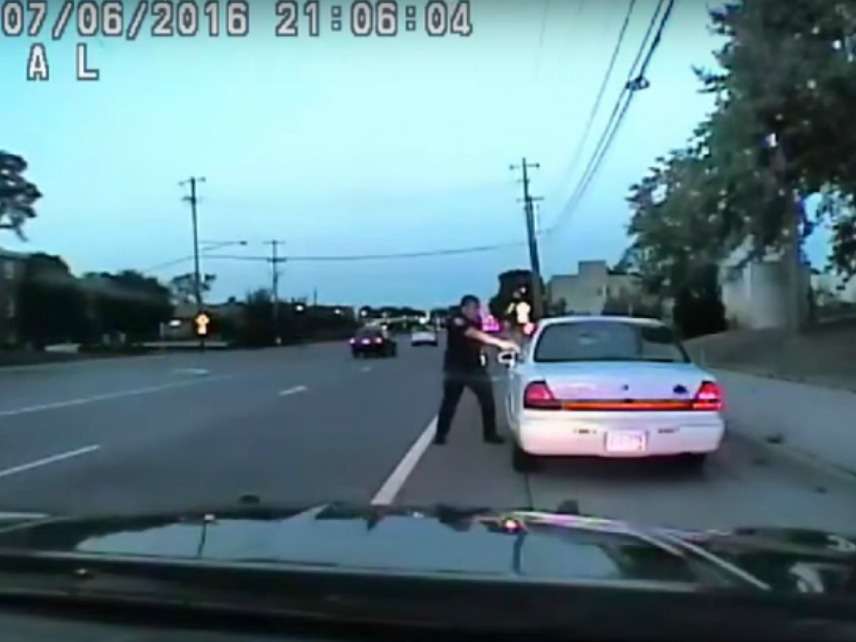Philando Castile Video Shows a Cop Who Panicked and Killed an Innocent Man
Officer Jeronimo Yanez's claim that he saw Castile drawing a gun is utterly implausible.

Much has been made of the fact that the dashcam video of the July 6, 2016, traffic stop in which Philando Castile was killed, which was finally released to the public yesterday, does not show what was going on inside his car—in particular, where he was reaching and for what. Jeronimo Yanez, the St. Anthony, Minnesota, police officer who shot Castile, initially said he thought Castile was reaching for a gun. Later he claimed to have seen Castile pulling out the pistol, which was found in a pocket of his shorts. Notwithstanding the gap in the video record, which the jurors who acquitted Yanez of second-degree manslaughter last week evidently thought was enough to create reasonable doubt, his story is utterly implausible.
To believe Yanez, you would have to believe that Castile, a law-abiding, peaceful cafeteria manager at a local elementary school who had a concealed-carry permit, was for some unknown reason bent on murdering the police officer who had pulled him over because of a faulty brake light. You would also have to believe that Castile, having decided to shoot Yanez, thought it was a good idea to calmly announce, "Sir, I have to tell you that I do have a firearm on me."
A more innocent explanation is that Castile meant to hand the gun over to Yanez for the duration of the traffic stop, which led to a fatal misunderstanding. But that explanation is inconsistent with the repeated assurances from Castile and his girlfriend, Diamond Reynolds, that he was not, in fact, reaching for his gun. "I wasn't reaching for it" was one of the last things Castile said as he sat, mortally wounded, in his car. So the only possibility, if you believe Yanez, is that Castile was bent on violence.
Far more likely is that Yanez told the truth in his initial account of the shooting: He believed Castile was reaching for a gun, but he never saw the weapon. Beginning immediately after the shooting (as you can hear in the dashcam video), Reynolds has consistently said Castile was actually reaching for his wallet to retrieve his driver's license, which Yanez had requested along with his insurance card. If you believe Reynolds (and Castile), Yanez made a mistake. Whether that mistake was excusable depends on whether Yanez reasonably believed that shooting Castile was the only way to avoid death or serious injury.
Yanez may indeed have believed that, but his belief was not reasonable. The officer's only basis for fearing Castile was the latter's purported resemblance to a robbery suspect (which was the real reason for the traffic stop). But that resemblance consisted entirely of commonly conjoined features: dark skin, a wide nose, dreadlocks, and glasses. Jeffrey Noble, an expert on police procedure, testified during Yanez's trial that the officer had "absolutely no reason" to view Castile as a criminal suspect. That initial misconception evidently colored everything that followed, even though Castile was polite, cooperative, and forthcoming in letting Yanez know about the gun.
Even if Yanez had good reason to fear Castile, Noble said, he could have addressed the threat he perceived by instructing the driver to put his hands on the dashboard, which he never did. Yanez also could have stepped back from the car window to the area between the front and back seats, which would have given him more space and time to react. Yanez did not take those precautions because he was not thinking clearly. Watching the dashcam video, which shows a calm exchange escalating into gunfire in just a few seconds, you see a man in full-blown panic.
Yanez's lawyers cited that short time span as a reason to cut him some slack: Reacting in the heat of the moment to what he perceived as a deadly threat, Yanez did what he thought was necessary to protect himself. (The day after the shooting, Yanez also claimed he had been thinking about his partner, who can be seen pulling back from the car in fear and surprise as Yanez fires seven rounds; Reynolds, who was nearly hit by one of those bullets; and her 4-year-old daughter, who was sitting in the backseat and probably did not perceive Yanez as protecting her.) If in retrospect Castile did not actually pose a threat (although Yanez insisted that he did), why punish the officer for making the wrong split-second decision in what he thought was a life-or-death situation?
That is the sort of reasoning that often gets cops off the hook even in the rare cases where their use of force leads to criminal charges. It is mistaken in this case because Yanez, like the cops who killed Tamir Rice and Zachary Hammond, created the perceived emergency that supposedly justified the use of deadly force. By making erroneous assumptions and failing to take obvious precautions, he put himself in a position where he thought he had no choice but to kill an innocent man who was guilty of nothing but exercising his Second Amendment rights.
Show Comments (44)